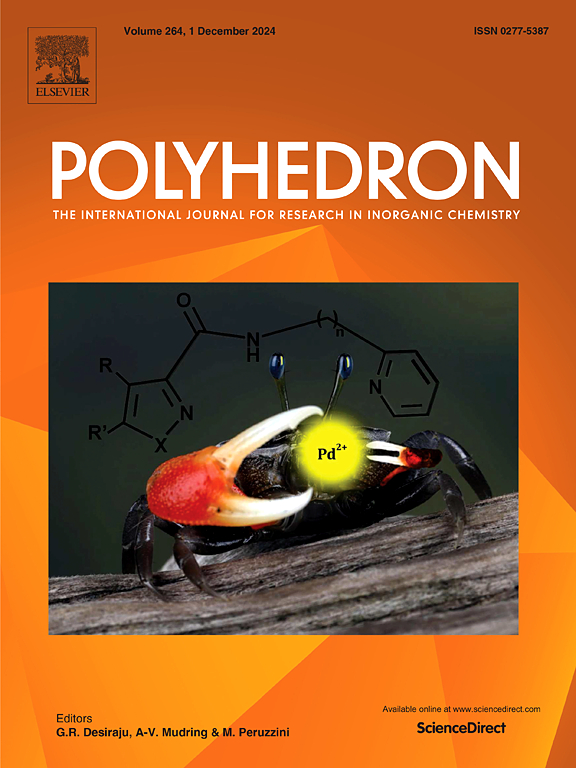钌(II)配合物[Ru(phen)2(o-CNPIP)]2+和[Ru(phen)2(o-CH3PIP)]2+在稀溶液和分子拥挤溶液中与双链RNA poly(rA)•poly(Ru)的相互作用
IF 2.6
3区 化学
Q2 CHEMISTRY, INORGANIC & NUCLEAR
引用次数: 0
摘要
双链RNA决定和调节细胞中的许多生物过程,在细胞信息传递和基因调控中起着至关重要的作用,是治疗某些疾病的关键靶点。本文合成并表征了两种新型钌(II)配合物[Ru(phen)2(o-CNPIP)]2+(Ru1)和[Ru(phen)2(o-CH3PIP)]2+(Ru2, phen = 1,10-菲罗啉,o-CNPIP =(2-(4-氰双吡啶)-咪唑-[4,5-f][1,10]-菲罗啉,o-CH3PIP = 2-(4-甲基)-咪唑-[4,5-f][1,10]-菲罗啉)。通过各种光谱方法和粘度测量研究了两种Ru (II)配合物与双链RNA poly(rA)•poly(Ru)在稀溶液和分子拥挤条件下的相互作用。紫外-可见吸收光谱和稳态发射光谱研究结果表明,Ru1对聚(rA)•聚(rU)具有较强的结合和稳定能力,而Ru1和Ru2对聚(rA)•聚(rU)的结合亲和力在分子拥挤条件下被削弱。随后,圆二色光谱研究、热变性测量和粘度测量的结果也证实了我们的紫外-可见吸收光谱和稳态发射光谱研究的结果。结果还表明,在稀溶液和分子拥挤条件下,两种Ru(II)配合物通过插层作用结合、稳定和扰动聚(rA)•聚(Ru)结构。此外,通过对比这些研究结果发现,这些能力的强弱与Ru(II)配合物对poly(rA)•poly(Ru)的结合亲和力密切相关。此外,两种条件下Ru(II)配合物与poly(rA)•poly(Ru)结合的热力学参数表明,该结合过程是自发的,是一个焓驱动的过程,氢键是主导力。本工作的目的是探讨Ru(II)配合物的取代效应以及溶液环境对Ru(II)配合物结合和稳定聚(rA)•聚(Ru)能力的影响。从这项工作中得到的一些见解有望促进基于Ru(II)配合物的高选择性双链RNA结合物的设计。有趣的是,在两种溶液条件下,Ru2与聚(rA)•聚(rU)结合后的磷光强度都明显高于Ru1,在分子拥挤条件下,其磷光强度更强。这表明Ru2具有作为生物细胞核酸成像的核酸发光探针的潜力。为了提高其发光性能和比结合力,进一步对Ru2进行结构修饰是我们今后研究的重点之一。本文章由计算机程序翻译,如有差异,请以英文原文为准。
![Interaction of ruthenium(II) complexes [Ru(phen)2(o-CNPIP)]2+ and [Ru(phen)2(o-CH3PIP)]2+ with double-stranded RNA poly(rA)•poly(rU) in both dilute and molecular crowding solutions](https://img.booksci.cn/booksciimg/2025-9/104309555631790056457.jpg)
Interaction of ruthenium(II) complexes [Ru(phen)2(o-CNPIP)]2+ and [Ru(phen)2(o-CH3PIP)]2+ with double-stranded RNA poly(rA)•poly(rU) in both dilute and molecular crowding solutions
Double-stranded RNA determines and regulates many biological processes in cells, plays a vital role in cell information transmission and gene regulation, and is a key target for the treatment of certain diseases. Here, we synthesized and characterized two novel ruthenium(II) complexes [Ru(phen)2(o-CNPIP)]2+(Ru1) and [Ru(phen)2(o-CH3PIP)]2+(Ru2, phen = 1,10-phenanthroline, o-CNPIP = (2-(4-cyanodipyrido)-imidazo-[4,5-f][1,10]-phenanthroline, o-CH3PIP = 2-(4-methyl)-imidazo-[4,5-f][1,10]-phenanthroline). The interaction of the two Ru (II) complexes with double-stranded RNA poly(rA)•poly(rU) under dilute solution and molecular crowding conditions was studied by various spectroscopic methods and viscosity measurements. The results of UV–vis absorption spectroscopy and steady-state emission spectroscopy studies show that Ru1 showed stronger binding and stabilizing ability to poly(rA)•poly(rU) and the binding affinity of Ru1 and Ru2 to poly(rA)•poly(rU) was weakened under molecular crowding conditions. Subsequently, the results of circular dichroism spectroscopy studies, thermal denaturation measurements and viscosity measurements also confirmed the results of our UV–vis absorption spectroscopy and steady-state emission spectroscopy studies. The results also showed that the two Ru(II) complexes bind, stabilize and perturb the structure of poly(rA)•poly(rU) by intercalation under dilute solution and molecular crowding conditions. In addition, it was found that the strength of these abilities was closely related to the binding affinity of the Ru(II) complexes to poly(rA)•poly(rU) by comparing the results of these studies. Furthermore, the thermodynamic parameters for the binding of Ru(II) complexes to poly(rA)•poly(rU) under the two conditions indicate that the binding process is spontaneous, is an enthalpy-driven process, and that hydrogen bonding serves as the dominant force. The purpose of this work is to explore the substituent effect of Ru(II) complexes and the effect of solution environment on the ability of Ru(II) complexes to bind and stabilize poly(rA)•poly(rU). Some insights resulting from this work are expected to facilitate the design of highly selective double-stranded RNA binders based on Ru(II) complexes. Interestingly, the phosphorescence intensity of Ru2 after binding to poly(rA)•poly(rU) is significantly higher than that of Ru1 under both solution conditions, with even stronger phosphorescence emission observed under molecular crowding conditions. This indicates that Ru2 possesses the potential to serve as a nucleic acid luminescent probe for nucleic acid imaging in biological cells. To enhance its luminescent properties and specific binding capacity, further structural modification of Ru2 is essential, which will be one of the key focuses of our future research efforts.
求助全文
通过发布文献求助,成功后即可免费获取论文全文。
去求助
来源期刊

Polyhedron
化学-晶体学
CiteScore
4.90
自引率
7.70%
发文量
515
审稿时长
2 months
期刊介绍:
Polyhedron publishes original, fundamental, experimental and theoretical work of the highest quality in all the major areas of inorganic chemistry. This includes synthetic chemistry, coordination chemistry, organometallic chemistry, bioinorganic chemistry, and solid-state and materials chemistry.
Papers should be significant pieces of work, and all new compounds must be appropriately characterized. The inclusion of single-crystal X-ray structural data is strongly encouraged, but papers reporting only the X-ray structure determination of a single compound will usually not be considered. Papers on solid-state or materials chemistry will be expected to have a significant molecular chemistry component (such as the synthesis and characterization of the molecular precursors and/or a systematic study of the use of different precursors or reaction conditions) or demonstrate a cutting-edge application (for example inorganic materials for energy applications). Papers dealing only with stability constants are not considered.
 求助内容:
求助内容: 应助结果提醒方式:
应助结果提醒方式:


